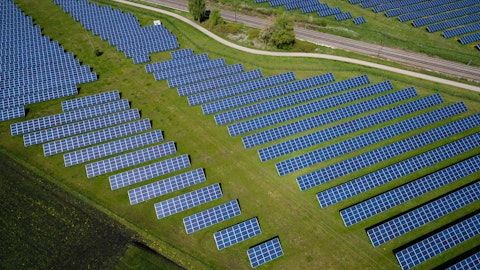Emeth Value Capital, an investment Management Company, released its second-quarter investor letter. A copy of the same can be downloaded here. Year-to-date, the fund returned 19.27% compared to the MSCI ACWI Index’s 14.19% return. Since inception, the fund returned 18.53%. In addition, you can check the top 5 holdings of the fund to know its best picks in 2023.
Emeth Value Capital highlighted stocks like Brookfield Renewable Partners L.P. (NYSE:BEP) in the second quarter 2023 investor letter. Headquartered in Hamilton, Bermuda, Brookfield Renewable Partners L.P. (NYSE:BEP) owns renewable power generating facilities. On October 4, 2023, Brookfield Renewable Partners L.P. (NYSE:BEP) stock closed at $20.87 per share. One-month return of Brookfield Renewable Partners L.P. (NYSE:BEP) was -12.46%, and its shares lost 31.20% of their value over the last 52 weeks. Brookfield Renewable Partners L.P. (NYSE:BEP) has a market capitalization of $14.178 billion.
Emeth Value Capital made the following comment about Brookfield Renewable Partners L.P. (NYSE:BEP) in its Q2 2023 investor letter:
“Brookfield Corporation has $9.2 billion invested through Brookfield Renewable Partners L.P. (NYSE:BEP), a publicly traded permanent capital vehicle that invests in renewable power and decarbonization solutions. The partnership is Brookfield’s longest standing listed investment vehicle and over the past two decades has assembled one of the world’s largest portfolios of hydroelectric, wind, solar, and renewable storage assets. The origins of Brookfield Renewable trace back to the Great Lakes Hydro Income Fund, which owned three hydroelectric generating stations located along the Lievre River that produced an annual average of 1,400 gigawatt hours (GWh) of electricity. Following its listing, Great Lakes Hydro under the leadership of Richard Legault acquired and developed an additional thirty-nine hydroelectric generating stations from 1999 to 2010, adding more than 4,000 GWh of annual electricity production. Meanwhile, because Great Lakes Hydro was a controlled subsidiary of Brookfield, Richard Legault, alongside other executives at Brookfield, spearheaded efforts to assemble an extensive portfolio of hydroelectric power assets that were owned by Brookfield directly. By 2010, Brookfield Renewable Power Inc., a wholly-owned subsidiary of Brookfield, had acquired 128 hydroelectric generating stations that it owned in addition to the assets owned via Great Lakes Hydro. Shortly thereafter, in 2011, Brookfield opted to consolidate all its renewable power assets into one investment vehicle under what was already a unified management structure, which formed Brookfield Renewable Partners. The new entity owned and operated 170 hydroelectric generating stations in North America and Brazil that produced 15,200 GWh of annual electricity, or more than a 10x increase since inception. In addition, the partnership inherited three wind facilities, two natural gas fired power plants, and a substantial 5,000 GWh development pipeline of renewable power projects. Notably, in contrast to more recently established renewable energy platforms, Brookfield Renewable Partners remained almost entirely hydroelectric power focused until 2011, and its cash flows remained over seventy percent hydro-centric until 2020. This resulted from Brookfield’s strong value orientation and aversion to projects that relied heavily on subsidy markets. Today, Brookfield Renewable Partners owns and operates 229 hydroelectric power facilities that produce an annual average of 20,000 GWh of electricity. These hydro assets remain the bedrock of the current portfolio and account for approximately half of the partnership’s $1.4 billion in asset-level cash flows. What’s more, quality of cash flows varies greatly across the renewables sector. Hydro assets achieve the highest relative capacity factors, offer natural energy storage solutions in the form of reservoirs, and, in contrast to solar and wind assets that have a useful life of twenty-five years, are perpetual in nature. For example, the original Lievre River assets that were contributed to the Great Lakes Hydro Income Fund were constructed between 1929 and 1954. In 2022, Brookfield Renewable Partners signed a new forty year power purchase agreement (PPA) with the government of Quebec to offtake the power from these exact assets. In other words, by the end of this term the oldest of these generating stations will have been revenue producing for more than 130 years. As a result, the capital required to sustain production from hydro is seven times less than that of wind and solar, resulting in a free cash flow conversion that is nearly fifty percent greater. Nevertheless, as hydroelectric assets have become increasingly scarce and as the economics of other renewable technologies have improved in recent years, Brookfield Renewable Partners has been rapidly scaling its solar and wind portfolio. At present, the partnership owns 131 wind facilities, 156 utility scale solar facilities, and more than 6,000 distributed generation facilities, often in the form of commercial and industrial solar or community solar installations…” (Click here to read the full text)

foxbat/Shutterstock.com
Brookfield Renewable Partners L.P. (NYSE:BEP) is not on our list of 30 Most Popular Stocks Among Hedge Funds. As per our database, 13 hedge fund portfolios held Brookfield Renewable Partners L.P. (NYSE:BEP) at the end of second quarter which was 17 in the previous quarter.
We discussed Brookfield Renewable Partners L.P. (NYSE:BEP) in another article and shared the list of best clean energy stocks to buy according to Wall Street analysts. In addition, please check out our hedge fund investor letters Q2 2023 page for more investor letters from hedge funds and other leading investors.
Suggested Articles:
- Analysts on Wall Street Lower Ratings for These 10 Stocks
- 25 Most Successful Small Business Ideas
- Top 25 Dividend Stocks of 2023
Disclosure: None. This article is originally published at Insider Monkey.



